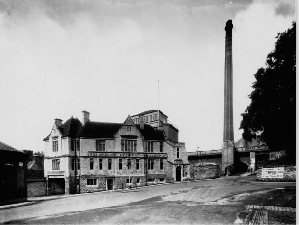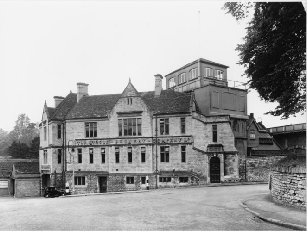



The Stanton family
The Stantons of Thrupp, near Stroud, were a well-
From 1879 or earlier, The Leaze was owned and occupied by James Thomas Stanton. Born in Stroud in 1831, he doesn’t seem to have followed in the family tradition of cloth making. By this time, the local industry was in something of a decline, so instead, he went into the brewing business.
In the 1881 census, he was recorded at being 50 years old and the head of the household that comprised family and servants at The Leaze. He was described as a brewer and magistrate. His business activities included part ownership of the Stroud Brewery Ltd, owned and operated post-
In the 1901 census he was still recorded as a Justice of the Peace of The Leaze, now aged 70. He died five years later in October 1906, leaving a wife, Louisa Loveday Stanton, sons Captain Harold James Clifford, Major Charles John, and Major Francis Henry Guy, and two daughters, Louisa Maud and Edith Sybil. Louisa soon followed James, dying in May 1907. Within a few years, the Stantons had gone, to be replaced by several generations of the de Lisle Bush family.
Throughout their time at The Leaze, James Stanton and his family appear to have played an active role in many of the parish organisations and remained involved in most areas of village life.
They supported the church and sponsored the annual Church Sunday Schools treat. Each year, children and teachers from the school, plus invited guests, were entertained in the grounds of The Leaze with swings, cricket, football, and various races.
In July 1884, the day before the treat, a large elm tree near the house was struck by lightning. A news report of the time noted that the tree “had been remarkably rent and shattered by the electric fluid’. It remained an object of awe for some time.
The family also entertained guests at various other notable village events. For instance, in 1886, following the re-
James Stanton was also heavily involved in less spiritual matters, regularly presiding over political meetings during the 1880s and 90s. He was also Chairman of Wheatenhurst Rural District Council, and was Chairman of the Board of Governors of the Wheatenhurst Union workhouse at Chipmans Platt. The family’s involvement with the latter also extended to less formal occasions and in January1891, several members helped to entertain the inmates. Gifts were distributed by and Mr and Miss G Stanton who also contributed to the performances. In recognition of James Stanton’s various benefactions, the East window of the church was later dedicated in his honour.
In what may have been a precursor of the dark days that were to unfold across Europe, in November 1899, James’ second son was recorded as being on his way to Africa with his regiment, en route to the Boer War that was to continue until 1902. Happily, he returned unharmed, unlike several sons of the family that were to follow him at The Leaze. However, within a few years of his return, both his parents were dead and the family had departed. In 1910, The Leaze stood empty.
Stephen Mills
Published in ECN 119 Jan/Feb 2010
Some further notes on the extended Stanton family -
Stantons in the woollen cloth trade
There are occasional references to Stantons being involved in several Stroud mills, although their main base was Staffords Mill near Stroud. This was bought by William in 1793. It was later operated by two sons, William and Henry /Charles. William was MP for Stroud for 1841-
The house called Field Place in Paganhill was bought by Charles Stanton in 1840. He died in 1863 and was succeeded by Charles Holbrow Stanton (barrister of Lincoln’s Inn), who was in turn succeeded by his son Also Charles. He lived there until 1897. At some point before1919, Arthur William Stanton was there. He died in 1944.
Stroud’s Turkish Baths
Several Stantons were involved with the Stroud (Turkish?) Baths Society Limited formerly located in Gloucester Street in Stroud. The company seems to have been formed in 1869 with the object of: '...establishing, building, maintaining Public Baths of every description in the town of Stroud...' In 1870, the average number of shareholders: 112, holding 627 shares.
Shareholders included:
Stanton, Alfred (Manufacturer) 10 shares
Stanton, James Thomas (Brewer) 10 shares
Pub connections
Old Crown, Farm Hill Lane, Parkend, Paganhill
Listed as the Old Crown, Whiteshill in 1891 and 1903.
Owner in 1891: Charles H. Stanton (leased to Godsell & Sons, Salmons Spring Brewery, Stroud)
Rateable value in 1891: £11.5s.0d.
Type of licence in 1891: Beerhouse
Owner in 1903: Charles H. Stanton (leased Godsell & Sons, Salmons Spring Brewery, Stroud)
1938: AW STANTON Esq, JP, sold to The Stroud Brewery Company, presumably the pub and land/property for around for £3,250.
Stroud Brewery
Later based in Stroud's Rowcroft, this brewery was founded in the mid-
Following his death in October 1855, Joseph Watts bequeathed the brewery to his grandson Joseph Watts Hallewell. In order to develop the business, he formed a partnership and the brewery traded as Watts Hallewell, Biddell and Stanton. The company was registered in 1888 and, by the time it merged with the Cheltenham and Hereford Breweries, a tied estate of 643 tied houses were being supplied. It merged with Cheltenham & Hereford Breweries Ltd In 1958 to form West Country Breweries. When Whitbread's acquired the combined companies in 1963, the Stroud Brewery was demoted to a supply depot until it was demolished in 1970.
The partnership was recorded in various trade directories of the period. For example: ,
Gloucestershire 1863 Brewers & Drinks manufactories. ... Hallewell, Watts, Biddell & Stanton, Stroud Brewery, Wallbridge, Stroud.


Stroud Brewery, Rowcroft, Stroud
The History of Eastington Park ( ‘The Leaze’)

